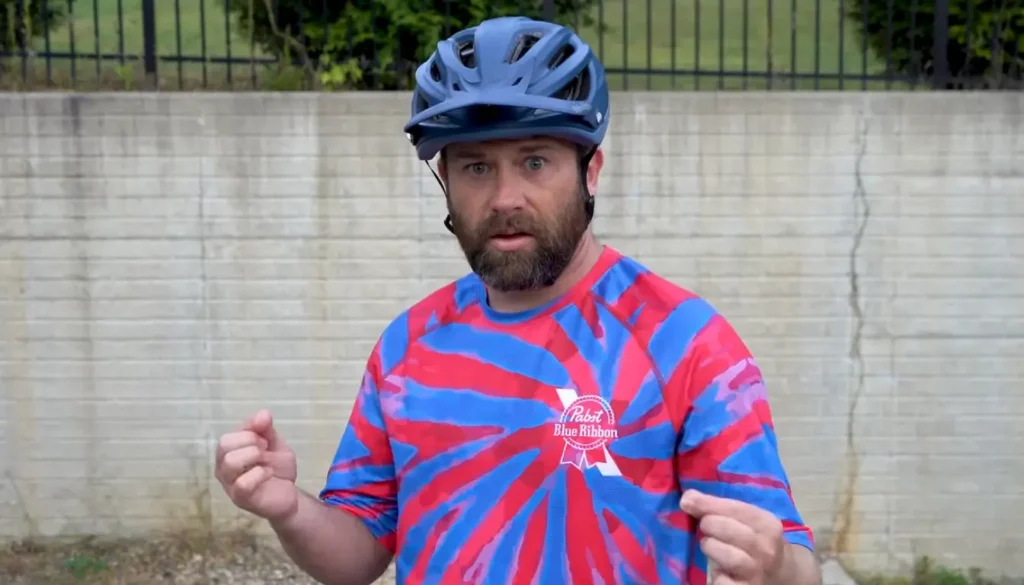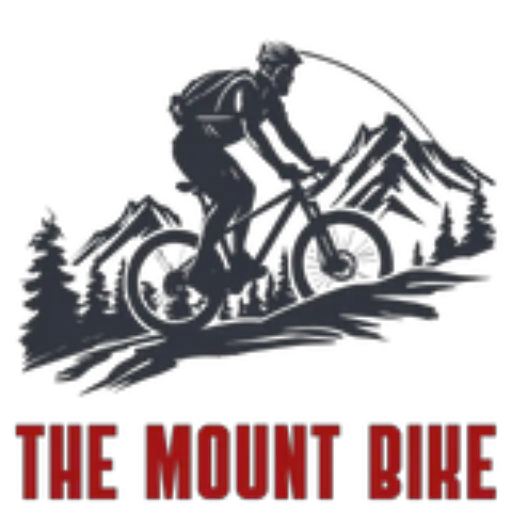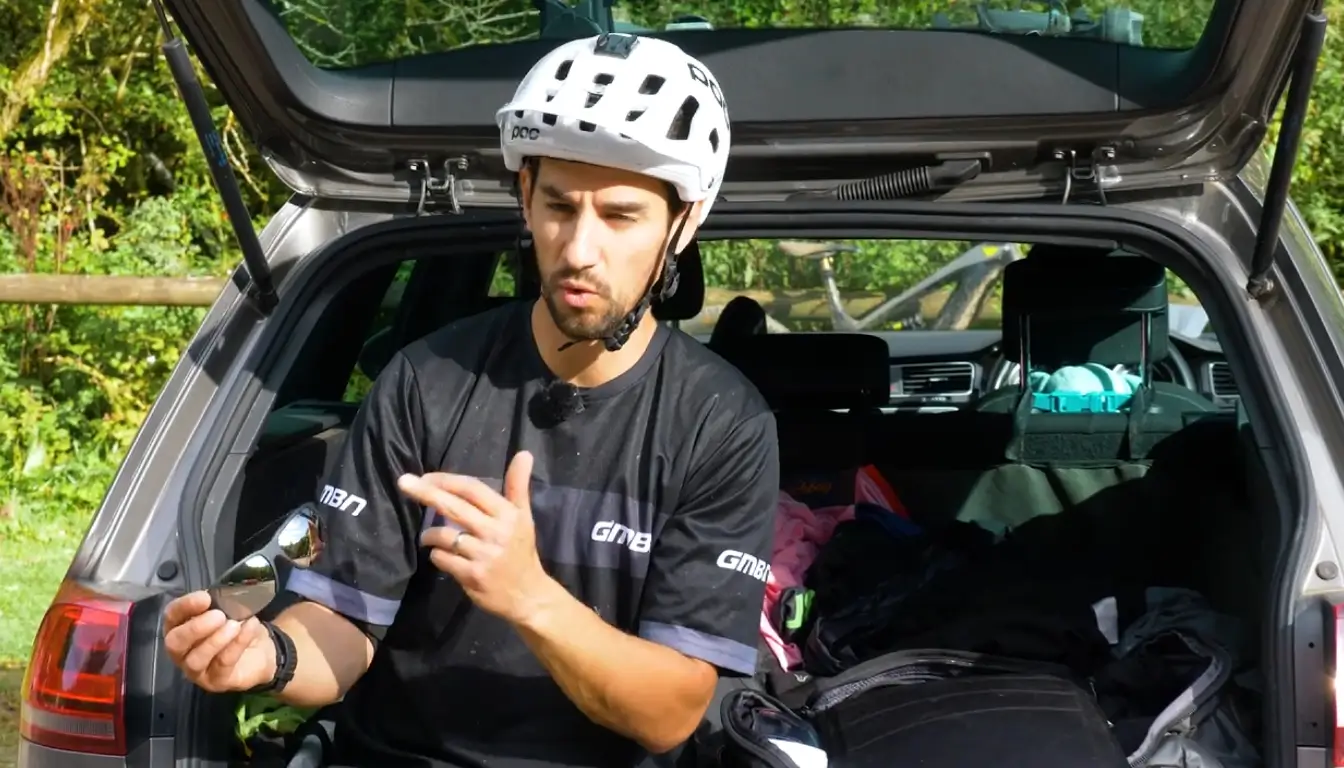Well, there are no rules about wearing different or special clothes for mountain biking. You can wear your regular T-shirts, shorts and running shoes for mountain biking. But if you want to enjoy a more comfortable, and safe ride, you should wear some gear and accessories. Such as MIPS-certified helmets, glass or goggles, knee pads, mountain bike shoes, quick-drying tops/jerseys and shorts, and hand gloves. These are the basic things you should wear for mountain biking, but you will find more specific accessories like a t-shirt for summer, a jacket for winter, mountain bike shorts for summer, and many more.
You shouldn’t wear the summer jersey in winter, or mtb shoes designed for flat terrain on rough terrain. Wrong dress-up can make things go wrong. So you need to know about your MTB wearing in detail, so you can decide which to wear and when. Let’s scroll down to know in detail.
What To Wear For Mountain Biking
Mountain biking is a physically demanding activity, which means that you’ll need clothes that will protect you from various difficulties and injuries. If your bike is equipped with suspension, then make sure to wear pants or MTB bike shorts that are perfect-fitting so that they don’t balloon up in the wind. Let’s know a few more gears you should wear for mountain biking and why.
Wear comfortable but Breathable clothes such as mesh t-shirts, or bike shorts, which allow air circulation throughout your body without binding you while pedaling and let you move freely. Mountain bike clothing includes perfect-fitting pants that are not too tight or too loose, a mountain bike jersey, as well as appropriate sleeves and a hood if necessary. These clothes can help minimize skin exposure to the sun, wind, and rain while you’re trail riding.
Never forget your helmet! It will protect the front of the skull by absorbing impact energy, preventing damage to the facial bone or teeth, and protecting the back of the skull and spinal cord. Wearing a mountain biking helmet can help to protect your head and brain in the event of an accident. When you’re riding downhill on a trail, it’s especially important to wear a helmet because the force exerted against your skull as you ride will be greater than when you are climbing or going around curves. Even small changes in steering or speed can result in high levels of impact stress on the brain and skull. And the helmet is not only essential for protection but also for sun exposure and rocks/stones on the ground.
Glass or Goggles for eye protection. When mountain biking, you are constantly dealing with potential danger. This includes rocks and trees that can be randomly thrown your way. Not to mention, the trails can become very slippery due to rain or mud and are hard to pedal. Wearing a pair of glasses or goggles helps protect your eyes from dirt and debris while also keeping them shielded from vandalism and other dangers on the trail. Not only do they protect your eyes from dirt and rocks, but they also help to keep the wind out of your face while you’re shredding down the trail.
Knee pads are essential for mountain biking because they protect your knees from impact and debris that may be thrown up by the bike. They also provide protection against cuts and bruises, which can occur when you fall to the ground or collide with other riders. Additionally, knee pads help to improve your flexibility and posture while riding. Lastly, wearing knee pads helps reduce fatigue during long rides by absorbing shocks transferred through the pedals and frame of the bike.
Hands gloves are another need while mountain biking. During an MTB ride, the odds of getting a hand injury go up dramatically. Not only do you have to worry about crashing into rocks or other objects, but your hands also get wet and cold while riding. This combination can lead to sprains, fractures, and even amputations. To ward off these potential disasters, it is important to wear gloves when mountain biking.
Mountain biking shoes are your best friend in a mountain biking ride. Mountain bike shoes are specifically designed to provide stability while you ride, allowing you to go further and faster with less fatigue. They also have grippy surfaces that help prevent slippage when moving up or down hills, as well as flexible materials to absorb shock when hitting bumps in the road. All these features make them crucial for any mountain biker looking to enjoy the thrill of downhill riding without fear of injury or damage to their equipment.
What Not To Wear Mountain Biking
- You shouldn’t wear cotton clothes for mountain bike riding. Because cotton takes time to dry, and leaves a rider feeling damp for a long time. While mountain bike riding you will sweat very frequently, so you should wear such clothes that can dry quickly.
- Loose clothing like flared trousers is not the perfect one to wear on an MTB ride. They can get caught in the bike’s gears or wheels, which could lead to serious injuries.
- Just like loose clothes, tight clothes are also avoidable. Jeans or too-tight trousers are two most popular pants mountain bikers wear and suffer from torn muscles and ligaments. This type of clothing causes compression forces against muscles and joints, potentially causing pain and inflammation.
- Knee-high socks or ankles are totally forbidden. They may prevent your feet from getting enough air. Bike riding causes your feet to absorb impact and the joints between your toes and ankles to receive excess pressure. So your feet need enough air, and knee-high socks or ankles prevent this and cause inflammation and pain.
- Avoid wearing regular sneakers as they are too soft. With these shoes, the spikes on the bottom can puncture asphalt or dirt while you ride, and can cause serious injuries. Plus, they do not offer the degree of traction or protection needed for this type of activity.
What To Wear Mountain Biking in Summer

Mountain biking in summer can be quite hot, so it is important to wear mountain bike clothing that will keep you cool yet comfortable. If you wear winter clothes on summer days, it can be a recipe for disaster. Because when it’s hot outside, your body will produce more sweat, which will lead to excessive water loss and dehydration. So, in order to stay cool and safe while MTB riding in summer, you’ll want to follow some basic guidelines including the right clothing.
Try wearing a lightweight cloth that is also breathable to keep you cooler like jersey or mesh, not cotton. Ready yourself with more wearing like a hat, sunglasses, sunscreen (SPF 30 or higher), insect repellent, and baggy shorts. Don’t forget fingerless gloves, they work well for those who are prone to feeling sweaty palms when cycling in hot weather climates. Remember to drink plenty of fluid during the day, water does wonders for cooling down and prevents you from becoming dehydrated;
Finally, ride during the cooler hours when temperatures are also plan an escape route in case of rain or thunderstorms.
What To Wear For Mountain Biking in Winter
Just like your winter wearing are not suitable for a summer ride, summer gear also can’t give the needed protection in winter. For winter mountain biking, consider wearing that are specifically designed for the winter season. For example, wear a few layers of clothes, long pants, full-finger gloves, mid-high socks, waterproof boots, a hat, and a scarf or neck gaiter to keep your extremities warm. Let’s know about them in detail.
- In winter, you should use a heavier cloth like a Synthetic Blend Cycling Jersey with troy lee designs. This type of cloth is designed to wick away sweat and moisture so that you remain dry and warm throughout the ride. It also provides excellent wind protection so that you don’t get chilled too easily.
- If you are going for more strenuous rides or if you’ll be spending lots of time in colder temperatures, consider wearing layers. Start with a base layer of moisture-wicking material to keep sweat away from your skin. Add an insulating layer like a fleece or wool sweater, and top it off with a waterproof and windproof jacket.
- Pants should be made of durable fabric like nylon or polyester, and they should fit snugly to avoid getting caught on branches or rocks. Trousers with insulation like fleece lining is also a good option for winter.
- Unlike mountain biking in summer, you will need full-finger waterproof and insulated hand gloves to keep your hands warm. These gloves will keep your hands dry while still allowing you to feel the grip of the bike.
- Next, you will need waterproof, and breathable shoes that won’t absorb water or snow. The soles of the shoe should also be designed to grip the ground securely in cold weather conditions.
What To Wear Mountain Biking in The Rain
When mountain biking in the rain, you’ll need to be prepared for a wet and muddy ride with proper mountain biking gear. This is because trails during rainfall are often more slippery and hazardous than usual. You should wear waterproof clothing including waterproof socks, pants, boots, a jacket or shell (if available) to keep you dry and comfortable, and a helmet is a must for head protection from thunderstorms and wind. You should also consider choosing bright colors or reflective gear to stay visible in low-light conditions.
Additionally, make sure to bring an emergency whistle in case of an emergency stop or injury. And last but not least: stay hydrated!
What To Wear First Time Mountain Biking
While mountain biking can be experienced in various ways, most people will need to wear some type of mountain bike gear for the first time. Protective gear includes items such as shoes, clothes, and a helmet. It is important to choose the right gear so that you can ride safely and comfortably while minimizing your risk of injuries.
Start by buying an MIPS-certified helmet for head protection, and a good pair of MTB shoes that fit well and protect your feet. You should also invest in mountain biking gloves (hand gloves), elbow pads, and knee pads for safety. Mountain bike apparel is also important to make the ride more comfortable and enjoyable.
All these gears are not so essential, that you should definitely have them for the first mountain bike ride. You can just go ahead with what you have. But as it’s your first MTB ride, naturally, you will face a few falls, so wearing the right mountain bike clothing and other gear will keep you safe from injury. And finally, make sure to bring along some sunscreen and insect repellent for when you hit the trails! While choosing the wearing you should also take into account your activity level and determine what type of clothing is necessary for that particular ride.
For beginners or those who don’t work up a sweat, cotton dress shirts and shorts can be adequate.
What Kind of Shoes To Wear For Mountain Biking
Unlike road bike, Mountain biking is a sport that involves riding on trails and through obstacles, so it is important to choose the right shoes. There are many different types of shoes that can be worn for mountain biking, but two types of shoes are the most popular flat shoes and clipless shoes.
Flat mountain biking shoes are a great option if you want to ride on dirt, gravel, or even some pavement with flat pedals. They’re fitted with spikes that help to grip the ground and provide stability when you’re off the bike. The flat design also means that they don’t get caught in cracks or holes like traditional mountain bike shoes do.
Additionally, these shoes have a wider base than regular MTB shoes which helps them float over obstacles more easily. This makes them well-suited for riding downhill and through obstacle courses.
Another great investment is buying clipless mountain biking shoes. These shoes are durable and stable. They are attached to the clipless pedals with cleat mechanisms, which allow for continuous power transmission and prevent the foot from slipping. They are also designed to provide good ankle stability so that mountain bikers don’t have to worry about losing balance or falling off their bike.
Some mountain bikers prefer to wear shoes with a lot of padding to protect their feet from the bumps and bruises that can come from riding over rough terrain, while others prefer lighter-weight shoes for better pedaling efficiency. Ultimately, it is up to the individual mountain biker to decide what type of shoe works best for them.
FAQ
Do I Need Special Shoes For Mountain Biking
Mountain biking can be a very physically demanding activity, and it is important that you wear the right shoes to avoid foot and ankle injuries. But there are no rules you have to wear special shoes for mountain biking. You can wear your regular boots for mountain biking.
Do You Have To Wear a Helmet on a Mountain Bike?
Yes, you have to wear a helmet on a mountain bike to keep yourself safe. Mountain biking means riding on tough trails, climbing uphill, going downhill, and lots more. Wearing a mountain bike helmet can help protect your head in the event of a fall or collision. So you should definitely wear a helmet on a mountain bike or whatever bike you are using for safety.
Are Mountain Bike Gloves Necessary?
Yes, mountain bike gloves are one of the necessary accessories to protect your hands from harsh elements like wind, sun, and rain and provide extra grip on the handlebars and help to absorb vibrations. If you do a lot of mountain biking, or if you simply want to be as comfortable as possible on your rides, investing in a good pair of gloves is a wise decision.
What Pants To Wear Mountain Biking
If you’re planning on doing lots of dirt biking or off-roading, then waterproof/breathable pants may be a good option, such as nylon or polyester. But be ensure the pants fit you perfectly, too loose or tight can make you uncomfortable. These days, some padded shorts are available that have some padding in the seating area. This type of mountain biking shorts will help cushion your bum while you’re riding and make for a more comfortable experience overall.

I am Ryan Ford, a mountain biking enthusiast who loves to explore the outdoors. I also like to go on adventures with friends and anything else that involves being outside. I love my bike because it gets me out of the house and gives me an opportunity to enjoy nature.

